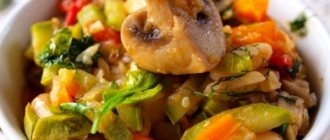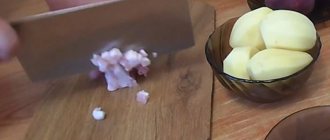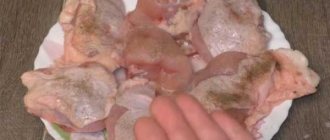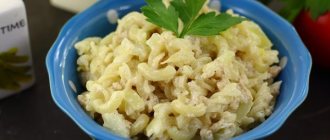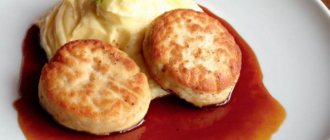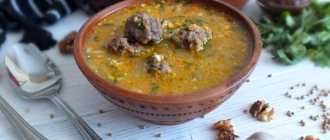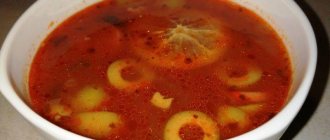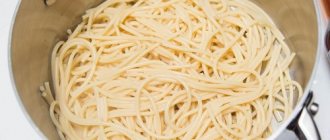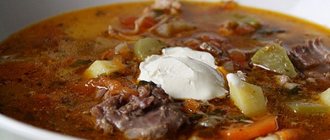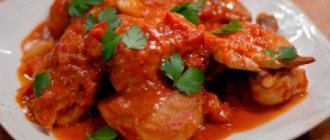3
Prepared by: Oksana Gorshkova
06/13/2018 Cooking time: 1 hour 0 minutes
| Save | I cooked) | Estimate |
This is a very simple, tender and tasty soup. The aroma of turkey is emphasized by celery and marjoram, and the light sweet taste of poultry harmonizes perfectly with potatoes.
Cooking features
Even a novice housewife can cook a delicious turkey leg soup, as this process is not complicated. However, to get the best result, it doesn’t hurt for the cook to know and take into account several important points.
- Fresh and chilled poultry is almost always more tender and juicy than frozen poultry. However, you can use frozen turkey drumsticks for the soup, which are usually cheaper than refrigerated ones. It is only important to give them the opportunity to thaw in natural conditions, without a sharp temperature change. Trying to speed up the process by using a microwave or warm water may cause the turkey leg to become even tougher.
- When choosing a turkey, pay attention not only to its expiration date, but also to its condition. Preference should be given to a product with pink or white skin. Fresh legs are elastic and easily return to their original shape after pressing on them with a finger. An unpleasant odor, yellow color of the skin, or loss of elasticity in the meat indicate that the product is stale; it is advisable to refrain from purchasing it.
- Turkey leg meat, especially from older birds, is quite tough. In order for it to become soft, it is advisable to cook the turkey legs for at least an hour. It is better to choose specimens weighing up to 0.5 kg. It is recommended to cook large drumsticks for 1.5 hours. Then the meat will soften and the broth will be rich.
- Greens are often added to turkey soup. After introducing this component, the soup must be boiled for at least 2-3 minutes, otherwise it will quickly spoil.
Turkey meat goes well with almost any food. Turkey drumstick soup can be made with just vegetables, combining them in different ways, as well as with the addition of noodles, rice, and other cereals. The technology for preparing turkey leg first courses can be different, depending on the composition of the particular dish. In order to avoid mistakes and get the expected result, it is advisable to follow the recommendations that accompany a specific recipe.
Weigh the benefits and harms of turkey broth
This problem has existed since people began to raise poultry on an industrial scale, using all kinds of growth stimulants, hormones, antibiotics and other chemicals that increase the profitability of poultry farming, but, unfortunately, worsen the nutritional properties of meat. So today we can get more poisons in soup than substances beneficial to the body. After all, during the cooking process, many chemical compounds pass from meat into water, clogging the intestines, liver and kidneys.
For example, tetracycline, used on poultry farms as an antibiotic, completely passes into the water and remains there even after boiling for half an hour. Heavy metals can often remain in broth and dishes based on it. And the longer you cook it, the more concentrated it becomes, the greater the danger it poses to humans.
In addition, the liquid dish is absorbed too quickly, bypassing processing in the liver. And this leads to clogging of the main filter of the human body, negatively affecting the intestines and organs into which the unrefined product enters. It also dilutes gastric juice and, as a result, reduces acidity. Therefore, boiled turkey will be safer and more beneficial than a decoction from it.
However, it is still possible to restore strength with the help of this food, since other foods often simply cannot be digested during various intestinal infections. The body refuses to accept hard, cold or raw foods, as they provoke stomach pain or nausea.
Turkey broth is especially popular. It contains significant amounts of proteins and B vitamins, which improve metabolism and energy metabolism and stimulate brain function. And minerals strengthen the immune system (iron), strengthen the nervous system (magnesium), prevent cancer (selenium), strengthen bones, teeth and hair (phosphorus and potassium).
You can avoid poisoning your body with meat broth if you cook it following certain recommendations.
Classic turkey leg soup recipe
Compound:
- turkey drumstick – 0.5 kg;
- onions – 100 g;
- carrots – 100 g;
- potatoes – 0.4 kg;
- refined vegetable oil – 40 ml;
- fresh parsley – 20 g;
- salt, pepper - to taste;
- laurel leaves – 2 pcs.;
- water – 2 l.
Cooking method:
- Wash the turkey drumstick, place it in a saucepan, cover with cold water and place on the stove.
- Over medium heat, bring the contents of the pan to a boil. Cook for 10 minutes, skimming off the foam. Add laurel leaves. Reduce heat, cover the pan with a lid. Leave to cook until the meat begins to fall off the bone.
- Peel the onion and cut into small cubes.
- Scrub the carrots, wash them, and pat dry with a napkin. Grind on a grater with large holes.
- Heat the oil in a frying pan, fry the onions and carrots in it until golden brown.
- Peel the potatoes and cut into cubes about 1.5 cm in size.
- When the turkey drumstick is done, remove it from the broth. Remove the laurel leaves from it.
- Place potato pieces into the broth. Salt it. Boil the potatoes for 15 minutes.
- Separate the turkey meat from the bone and cut into portions. Place in the pan along with the roasted vegetables. Continue cooking for 10 minutes.
- Finely chop the greens and add to the soup. Wait for it to boil again. Let it boil for 2-3 minutes, remove the pan from the heat.
This version of turkey leg soup is the simplest of the existing ones, but it also makes a delicious first course.
How to make Potato Turkey Chowder
Make a strong turkey broth. You can take a drumstick, a wing or trimmed bones. The main condition is to cook over low heat, adding baked roots in the middle of cooking. Strain the finished broth and remove the turkey meat from the bones, removing the tendons.
For 600 g of potatoes you should take 1.5 - 2 liters of broth. Bring the strained broth to a boil and add potatoes cut into large cubes, preferably crumbly varieties, into it. After boiling, add salt and cook until the potatoes are soft.
Cut the carrots and celery into thin slices, chop the onion into strips. Fry the vegetables in oil until lightly golden.
Mash the potatoes lightly with a masher, never achieving a puree-like consistency. Just to thicken the soup a little.
Dip turkey meat and roasted vegetables into the soup. Let it boil.
Add chopped green onions, parsley and marjoram to the soup. Turn off the heat.
Let the soup simmer, covered, for 15 minutes.
Turkey leg soup with rice
Compound:
- turkey drumstick – 0.5 kg;
- potatoes – 0.4 kg;
- rice – 100 g;
- onions – 150 g;
- carrots – 150 g;
- refined vegetable oil – 40 ml;
- fresh dill and parsley – 15-20 g each;
- water – 2.5 l.
Cooking method:
- Pour water over the turkey drumstick and boil until done.
- Cool the turkey leg and strain the broth.
- Peel the carrots and cut into small cubes.
- Remove the peel from the onion and cut into small cubes.
- Place the onions and carrots in a frying pan with heated vegetable oil and brown them.
- Rinse the rice until it is clean.
- After peeling the potatoes, cut them into cubes about 1 cm in size.
- Remove the skin from the turkey drumstick. Separate the meat from the bones and cut.
- Place all prepared foods into the broth. Add salt and season to taste.
- Bring the contents of the pan to a boil, cook for half an hour over low heat. 5 minutes before readiness, add chopped herbs.
Recipe Diet soup with turkey without potatoes. Calorie, chemical composition and nutritional value.
Nutritional value and chemical composition of “diet soup with turkey without potatoes.”
The table shows the nutritional content (calories, proteins, fats, carbohydrates, vitamins and minerals) per 100 grams of edible portion.
| Nutrient | Quantity | Norm** | % of the norm in 100 g | % of the norm in 100 kcal | 100% normal |
| Calorie content | 53.8 kcal | 1684 kcal | 3.2% | 5.9% | 3130 g |
| Squirrels | 7.4 g | 76 g | 9.7% | 18% | 1027 g |
| Fats | 0.5 g | 56 g | 0.9% | 1.7% | 11200 g |
| Carbohydrates | 4.7 g | 219 g | 2.1% | 3.9% | 4660 g |
| Organic acids | 0.1 g | ~ | |||
| Alimentary fiber | 1.5 g | 20 g | 7.5% | 13.9% | 1333 g |
| Water | 85.4 g | 2273 g | 3.8% | 7.1% | 2662 g |
| Ash | 0.488 g | ~ | |||
| Vitamins | |||||
| Vitamin A, RE | 356.6 mcg | 900 mcg | 39.6% | 73.6% | 252 g |
| beta carotene | 2.253 mg | 5 mg | 45.1% | 83.8% | 222 g |
| Vitamin B1, thiamine | 0.039 mg | 1.5 mg | 2.6% | 4.8% | 3846 g |
| Vitamin B2, riboflavin | 0.035 mg | 1.8 mg | 1.9% | 3.5% | 5143 g |
| Vitamin B4, choline | 23.1 mg | 500 mg | 4.6% | 8.6% | 2165 g |
| Vitamin B5, pantothenic | 0.363 mg | 5 mg | 7.3% | 13.6% | 1377 g |
| Vitamin B6, pyridoxine | 0.15 mg | 2 mg | 7.5% | 13.9% | 1333 g |
| Vitamin B9, folates | 2.217 mcg | 400 mcg | 0.6% | 1.1% | 18042 g |
| Vitamin B12, cobalamin | 0.051 mcg | 3 mcg | 1.7% | 3.2% | 5882 g |
| Vitamin C, ascorbic acid | 1.01 mg | 90 mg | 1.1% | 2% | 8911 g |
| Vitamin E, alpha tocopherol, TE | 0.232 mg | 15 mg | 1.5% | 2.8% | 6466 g |
| Vitamin H, biotin | 0.218 mcg | 50 mcg | 0.4% | 0.7% | 22936 g |
| Vitamin K, phylloquinone | 3 mcg | 120 mcg | 2.5% | 4.6% | 4000 g |
| Vitamin RR, NE | 1.7465 mg | 20 mg | 8.7% | 16.2% | 1145 g |
| Niacin | 1.969 mg | ~ | |||
| Macronutrients | |||||
| Potassium, K | 170.6 mg | 2500 mg | 6.8% | 12.6% | 1465 g |
| Calcium, Ca | 21.22 mg | 1000 mg | 2.1% | 3.9% | 4713 g |
| Silicon, Si | 9.022 mg | 30 mg | 30.1% | 55.9% | 333 g |
| Magnesium, Mg | 32.18 mg | 400 mg | 8% | 14.9% | 1243 g |
| Sodium, Na | 9.53 mg | 1300 mg | 0.7% | 1.3% | 13641 g |
| Sera, S | 71.45 mg | 1000 mg | 7.1% | 13.2% | 1400 g |
| Phosphorus, P | 76.5 mg | 800 mg | 9.6% | 17.8% | 1046 g |
| Chlorine, Cl | 21.41 mg | 2300 mg | 0.9% | 1.7% | 10743 g |
| Microelements | |||||
| Aluminium, Al | 98.1 mcg | ~ | |||
| Bor, B | 64.4 mcg | ~ | |||
| Vanadium, V | 23.75 mcg | ~ | |||
| Iron, Fe | 0.843 mg | 18 mg | 4.7% | 8.7% | 2135 g |
| Yod, I | 2.14 mcg | 150 mcg | 1.4% | 2.6% | 7009 g |
| Cobalt, Co | 3.709 mcg | 10 mcg | 37.1% | 69% | 270 g |
| Lithium, Li | 0.838 mcg | ~ | |||
| Manganese, Mn | 0.122 mg | 2 mg | 6.1% | 11.3% | 1639 g |
| Copper, Cu | 76.86 mcg | 1000 mcg | 7.7% | 14.3% | 1301 g |
| Molybdenum, Mo | 6.574 mcg | 70 mcg | 9.4% | 17.5% | 1065 g |
| Nickel, Ni | 11.805 mcg | ~ | |||
| Rubidium, Rb | 28.6 mcg | ~ | |||
| Selenium, Se | 6.37 mcg | 55 mcg | 11.6% | 21.6% | 863 g |
| Strontium, Sr | 1.98 mcg | ~ | |||
| Titanium, Ti | 9.48 mcg | ~ | |||
| Fluorine, F | 70.4 mcg | 4000 mcg | 1.8% | 3.3% | 5682 g |
| Chromium, Cr | 3.21 mcg | 50 mcg | 6.4% | 11.9% | 1558 g |
| Zinc, Zn | 0.6327 mg | 12 mg | 5.3% | 9.9% | 1897 |
| Zirconium, Zr | 1.02 mcg | ~ | |||
| Digestible carbohydrates | |||||
| Starch and dextrins | 2.588 g | ~ | |||
| Mono- and disaccharides (sugars) | 2.1 g | max 100 g | |||
| Glucose (dextrose) | 0.603 g | ~ | |||
| Sucrose | 1.309 g | ~ | |||
| Fructose | 0.294 g | ~ | |||
| Essential amino acids | 0.085 g | ~ | |||
| Arginine* | 0.592 g | ~ | |||
| Valin | 0.439 g | ~ | |||
| Histidine* | 0.403 g | ~ | |||
| Isoleucine | 0.386 g | ~ | |||
| Leucine | 0.668 g | ~ | |||
| Lysine | 0.839 g | ~ | |||
| Methionine | 0.141 g | ~ | |||
| Methionine + Cysteine | 0.272 g | ~ | |||
| Threonine | 0.37 g | ~ | |||
| Tryptophan | 0.124 g | ~ | |||
| Phenylalanine | 0.373 g | ~ | |||
| Phenylalanine+Tyrosine | 0.666 g | ~ | |||
| Nonessential amino acids | 0.171 g | ~ | |||
| Alanin | 0.427 g | ~ | |||
| Aspartic acid | 0.723 g | ~ | |||
| Hydroxyproline | 0.058 g | ~ | |||
| Glycine | 0.315 g | ~ | |||
| Glutamic acid | 1.042 g | ~ | |||
| Proline | 0.387 g | ~ | |||
| Serin | 0.364 g | ~ | |||
| Tyrosine | 0.293 g | ~ | |||
| Cysteine | 0.134 g | ~ | |||
| Sterols (sterols) | |||||
| Cholesterol | 1.81 mg | max 300 mg | |||
| Saturated fatty acids | |||||
| Saturated fatty acids | 0.1 g | max 18.7 g | |||
| 14:0 Miristinovaya | 0.003 g | ~ | |||
| 16:0 Palmitinaya | 0.11 g | ~ | |||
| 18:0 Stearic | 0.025 g | ~ | |||
| 20:0 Arakhinovaya | 0.003 g | ~ | |||
| Monounsaturated fatty acids | 0.128 g | min 16.8 g | 0.8% | 1.5% | |
| 16:1 Palmitoleic | 0.033 g | ~ | |||
| 17:1 Heptadecene | 0.003 g | ~ | |||
| 18:1 Oleic (omega-9) | 0.159 g | ~ | |||
| Polyunsaturated fatty acids | 0.04 g | from 11.2 to 20.6 g | 0.4% | 0.7% | |
| 18:2 Linolevaya | 0.052 g | ~ | |||
| 18:3 Linolenic | 0.003 g | ~ | |||
| 20:4 Arachidonic | 0.005 g | ~ | |||
| Omega-6 fatty acids | 0.1 g | from 4.7 to 16.8 g | 2.1% | 3.9% |
The energy value of dietary soup with turkey without potatoes is 53.8 kcal.
- Serving = 248 g (133.4 kcal)
Primary Source: Created in the application by the user. Read more.
** This table shows the average levels of vitamins and minerals for an adult. If you want to know the norms taking into account your gender, age and other factors, then use the “My Healthy Diet” application.
How to properly cook turkey broth?
Try to use poultry raised on private farms and buy it from trusted people.
To choose a fresh bird, pay attention to its appearance: its legs and breasts should be round, its skin color should be even, white with a slight yellow tint, without spots.
For richness, take thighs and wings with the skin on. If you want to prepare a dietary soup, take fillet or breast.
